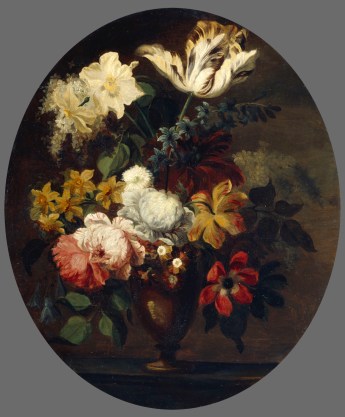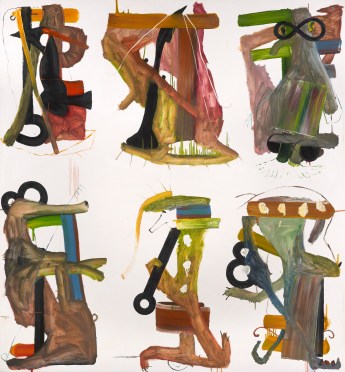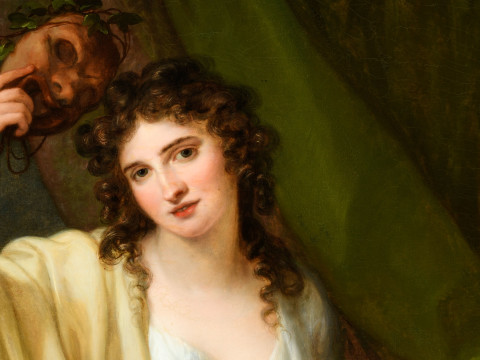
A "female invasion" 250 years in the making
By Annette Wickham
Published on 12 May 2018
The RA started out with two female Academicians, then took over a century to elect any more. As we celebrate our 250th anniversary, we take a look back at the women who fought the odds to be a part of our history – and the ones helping to secure our future.
Between 2015-2017, ten artists and architects were elected as Royal Academicians: five women and five men (the duo Gilbert & George RA was elected as a single artist), making for a perfect statistic of gender parity. In the past decade, the Academy has elected more women than ever before and seems on course to achieve equal representation in its membership. It has been a long time coming and the institution’s 250th anniversary seems a good time to reflect on the changing fortunes of women at the RA.

Perhaps surprisingly, the Academy got off to a good start in 1768. Two of its founding Members were women, the painters Mary Moser and Angelica Kauffman. However, this proved to be a high point for female representation that would not be equalled again until the mid-20th century. Moreover, looking beneath the surface, it transpires that the early Academy’s inclusivity only went so far. Moser and Kauffman were respected as artists but they were still treated differently from their male counterparts. Johan Zoffany RA’s group portrait of the Academicians in the Life Room, complete with two male models, puts this disparity into sharp focus. Social mores made it unthinkable for the women to attend the life class at this time, so Moser and Kauffman were relegated to being represented via their portraits on the wall.
Zoffany’s painting has been described by art historian Angela Rosenthal as an "icon of exclusion". She has a point; the women were kept out of more than just the Academy’s life class. It was taken for granted that they would play no active role in the running of the institution. Moser did attend some General Assembly meetings but wasn’t taken seriously. In 1803, at the annual election of RA President, in which Benjamin West was re-elected, Henry Fuseli RA had cast his vote for Moser, quipping: “Is not one old woman as good as another?”

Spring, ca. 1780

Summer, ca. 1780

Invention, 1778-80

Composition, 1778-80

Moser died in 1819 and the Academy continued for over a century thereafter without electing a single female RA. While female artists exhibited work in the Summer Exhibition every year and a handful were nominated for election, this was without success. In the day-to-day life of the Academy during this period, women were consigned to the roles of life models or domestic servants.
The first chink in the armour came in 1860 with the first female student to be admitted to the RA Schools. Laura Herford sent in a drawing for approval signed only with her initials and it was duly accepted before anyone twigged that she was a woman. Herford was followed by other female students but they were barred from life classes until the 1890s and their admission was strictly controlled to ensure that they didn’t outnumber the men. Even in the early 20th century, some of the male staff and students continued to regard the women as intruders, or “the female invasion”, as painter George Dunlop Leslie RA put it.
Similarly, the first significant step towards electing a successor to Moser and Kauffman provoked a backlash. Elizabeth Butler was fêted when she showed her atmospheric painting from the Crimean War, The Roll Call, in the 1874 Summer Exhibition. An artist’s success in this annual show often led to their nomination for election as an Academician, and Butler’s name appears in the Academy’s books shortly afterwards. In 1879 she lost by only two votes, ruffling the feathers of the less liberal Academicians. One of them even felt so strongly that he put forward the motion “That women be no longer eligible to be members of the Royal Academy.” Although the motion was not passed, it was a hypothetical scenario, as none was elected.
Finally, in 1922, the painter Annie Swynnerton became the first woman Associate of the RA (now a defunct category of membership). This historic breakthrough meant little in practice; Swynnerton was 78 years old by this point and never became a full RA. She was followed by Laura Knight who was elected as an Academician in 1936. Knight acknowledged the importance of her predecessor saying, “Any woman reaching the heights in the fine arts had been almost unknown until Mrs Swynnerton came and broke down the barriers of prejudice.”

Had the barriers really been broken? Yes and no. Knight was the toast of many a Summer Exhibition, and, in 1965, became the first female artist to have a solo retrospective at the RA. Yet, like Moser and Kauffman she remained an exception. Worse still, she had to wait until she was 84 and an RA of 30 years standing before receiving her first invitation to the institution’s Annual Dinner. It was Gertrude Hermes, the RA’s first female engraver, who was the catalyst for change. After a General Assembly meeting in 1966, she was appalled to discover that dinner was about to be served (“which smelled delicious” she recalled) but she and the other women members were not invited. Hermes wrote to the Academy, taking issue with the institution’s antiquated tradition of all-male dining and warning that “this splendid establishment cannot afford to lag behind in these matters”. In 1967, the four female Academicians (Knight and Dod Procter as RAs with Hermes and Jean Cooke as ARAs) were invited to dine alongside the men and distinguished female guests, including Barbara Castle and Lady Asquith. The Times reported that, after dinner, Hermes enjoyed “a thoroughly masculine cigar”.
Gradually, the number of women Academicians increased but it was a slow process. Sculptor Ann Christopher RA was one of only eight women at the Academy in 1980 and the youngest female sculptor ever to have been elected. She recalls “a very old school boys’ club atmosphere” and her overriding memory is of constantly being asked for ID by the staff, who assumed she couldn’t be a Member as she “didn’t have grey hair”. Christopher credits Hugh Casson, RA President between 1976 and 1984, with “trying to kick-start the move into the 20th century and encourage a more diverse membership”.

Drawing No. 11, 1974

Untitled (six on brown), 1989

Trying to Find You 1, 2007

Reclining Doll, 2013
This diversification of the membership has continued and picked up speed since the start of the new millennium. The Academy’s historic reticence over female Members has meant that a number of milestones are still being celebrated. The year 2011 proved significant, with the election of the Academy’s first female Professors, Fiona Rae (Painting) and Tracey Emin (Drawing). That year also saw the first female Keeper of the Royal Academy Schools, Eileen Cooper, followed by Cathie Pilkington and Farshid Moussavi as the first female Professors of Sculpture (2015) and Architecture (2017) respectively, while in 2016 Sonia Boyce became the first black female Academician. Cooper was succeeded as Keeper by Rebecca Salter in 2017. And in 2020 Marina Abramovic Hon RA will be the first woman to have a solo show across the entire Main Galleries.
There is one office at the Academy that is still waiting for a ‘first’. Will the next artist to don the President’s medal be a woman?
Annette Wickham is Curator of Works on Paper at the Royal Academy
Related articles

A love letter to the gallery gift shop
18 November 2024

Angelica Kauffman: Art History's Heroine
4 April 2024

Start here: Angelica Kauffman
24 January 2024

The meteoric rise of Angelica Kauffman RA
2 January 2024

10 novels about art you won't put down
10 June 2022
